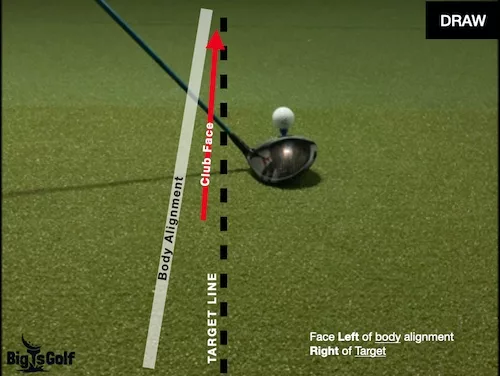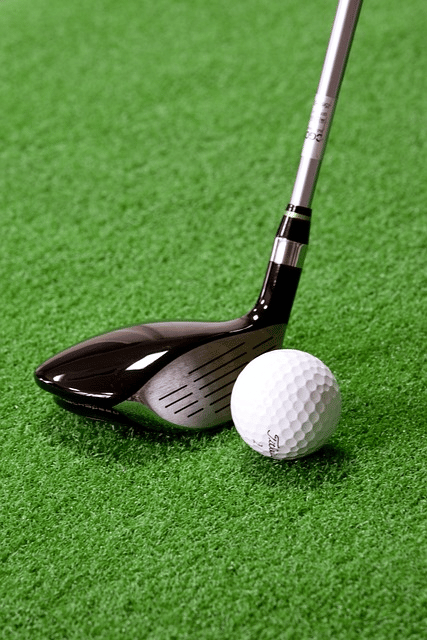Just like anything in golf, you’ll find an enormous amount of advice on hitting a draw. Some of it is great, but a lot of it is complicated and more difficult than necessary. I’m going to walk you through a very simple method to show you how to hit a draw. A method that works with your driver and irons.
What is a draw in golf? A draw is when a golfer hits the ball with a slight curve at the end of its flight path. The curve is right-to-left for a right-handed golfer and left-to-right for a left-handed golfer.
How to Hit a Draw – Step-by-Step

- Tee your golf ball slightly higher than normal
- Aim your feet and shoulders right of the target
- Aim your club face right of the target, but left of your body alignment
- Re-grip your club with the face properly aligned as described in step 3
- Try to swing a bit more in-to-out
- Rotate the toe of your club over on follow-through
How to Align Yourself to Hit a Draw
For a right-handed golfer, it is important to align your body to the right of your target. The club face should be closed a bit, aligned to the left of your body, but slightly right of the target line.
You’ll want to pay attention to your natural tendency to correct. When you line up, it’s likely you’ll feel a bit out of whack. I think this is largely due to the fact you’re looking at a closed club face.
I usually need to take an extra second to trust that I am lined up correctly to draw the ball.
These steps are the opposite of hitting a fade. You can also check out my article on draw vs fade.
Golf Swing to Hit a Draw
When hitting a draw, it’s important your swing path is a bit more in-to-out. You’ll want to tee the ball up a bit higher to promote hitting up on the ball as well.
As you follow through, turn the toe of the club over, naturally rotating your forearms. This will help to ensure the club face turns over, producing that nice right-to-left ball flight.
Many golfers try to take an in-to-out swing path on every shot anyway. If this is you, it should be a familiar approach. If that’s not you, this type of swing path can help you hit the ball straight if you struggle with a slice. So give it a shot!
What Causes a Draw

Ball movement in the golf swing is due to the face angle relative to the swing path. When the club face is closed, this is going to cause the ball to move right-to-left (for a right-handed golfer).
The reason for this is side spin. When you hit the ball with a glancing blow, it is going to put side spin on the ball. As the ball travels through the air, that side spin takes over and moves the ball.
Think of a curveball in baseball, or adding some english in billiards.
You may be interested in this article for a deeper-dive into golf ball flight patterns
Why Hit a Draw
You will likely encounter plenty of situations on the golf course where hitting a draw could benefit you. One of the most common may be a dog-leg left. Perhaps there are some trees on the left side of the fairway and you don’t have enough club to get over them.
You can go around them instead! This will allow you to cut the corner a bit and set yourself up for a shorter approach shot. For some holes, it can make the difference between having a reachable distance with your second shot on a par 5.
Having a draw shot in your arsenal can significantly improve your golf game. You’ll have more confidence! You’ll also have the option to attack certain greens or fairways that may have been out of reach otherwise.
Equipment Matters

Most modern drivers on the market have the ability to help correct bad shots. This often times means there is an adjustable weight on the back of the club. Before trying to execute a draw, you might consider giving this a quick check.
If you have the weight in the heal to help correct a slice for example, this may cause you to hit it much further to the left than wanted.
Golf balls can also effect your ability to hit a draw. Some golf balls are designed to reduce as much spin as possible. This increases distance and can also improve accuracy from the tee.
These types of golf balls may be more difficult to generate side spin, which is necessary to effectively hit a draw.
Practice Hitting a Draw
As with anything, it’s important to get some practice. It’s one thing to learn how to hit a golf draw on paper, it’s a whole lot different to apply it.
I’d recommend going to the driving range and be sure to bring an alignment rod with you. Alternatively, you can simply use a golf club.
Pick a target in the distance
Set your alignment rod aiming a couple of degrees to the right of the target
Set your club face left of the alignment rod, but slightly right of the target
Practice several shots, getting a feel for it. If you are struggling to execute it, go back to the basics and go through each of the 6 steps and refer to the diagram at the beginning of this article.
Tip – If you are struggling to execute a draw, or any golf shot for that matter, focus on your tempo to reduce all of the “noise” in your head.
Mental Preparation and Pre-Shot Routine
Visualizing your shot prior to hitting it is a critical success factor for any golf shot. Seeing yourself perfectly executing a draw, feeling your body swing through and rotate your hands over at the end of your swing.
Simply taking 3 seconds to visualize a perfectly hit draw prior to stepping up to the ball can build confidence in the shot. Your mind can actually trick your body into thinking you had a physical repetition when done properly.
Here is a deeper-dive into mental training for your golf game.
FAQ
Final Thoughts
It can be pretty rewarding to step up to the tee and perfectly execute whatever shot you’re trying to hit! If you want to hit a draw in golf, it only takes a little know-how and some practice. Learning how to hit any shot for that matter.
I hope this article has helped you learn how to hit a draw! Give it a try on the driving range and let me know if this helped you, I’d love to hear from you.
Good luck on the golf course!
